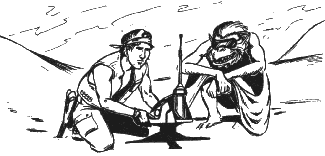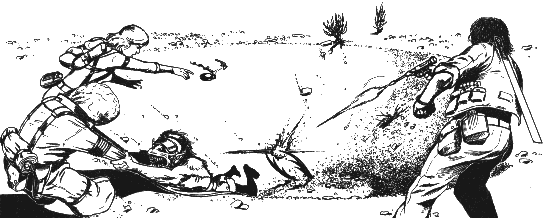After playing the two adventures you may want to play something new and different. You can, by making up your own adventures. Adventures are easy to make up if you do it step by step. If you played either of the adventures more than once, you have a general idea of how to make up new adventures. A step-by-step method for designing new adventures is given below.
Purpose
First, pick a story outline to be the basis for your adventure. This will make it easier to fill in the other parts of the adventure. The story can be about anything, such as a crash on a desert planet. You can make upyourown stories, or use ideas from your favorite books and movies.
Teams
Decide how many characters each team will have and what sort of equipment they own. The adventure can be played with two teams of adventurers (possibly from different companies) trying to get the same thing, or with only one team of player characters and another player, iike the reader in the first two adventures, controlling all other aeatures and characters. In the first case. both teams will be trying to beat each other. In the second, the player characters are trying to reach a goal, not defeat the reader.
Try to make sure that one side is not stronger than the other. Their Stamina point totals and numbers of attacks should be about the same. Dexterities and damage from attacks will vary, but you should try to balance them.
Choose weapons and equipment that will be useful in the adventur.e. You can use the system from Adventure 1, if you want. You should remember to include vehicles, if they are needed. One party may have a skimmer while the other has riding animals.
How to Win
Set goals for each team, so the players know what they must do to win. The goal should be related to the story. In our example, the players may need to find an abandoned radio beacon and call for help. The examples from the two adventures can help you pick a goal.
Set-Up
Choose the pieces and map you will use for the adventure. For a crash on an alien planet, you could use the desert map or the crater map.
If you want, you can even draw your own maps. Be sure to draw them big enough to put counters on, and include a 1/2" grid for movement and combat. include everything on the map that you need to play, like doors, roads, vital control panels, etc. Some maps you might want to make for adventures are an island, a space station or the inside of a large building.
Once you have picked your playing area, decide where each piece starts the adventure.
How To Play
Once you have a story and have picked your teams, goals and set-up areas, you must create any special rules needed to play the adventure. You also must decide which side will move first until combat starts and when special events will happen.
For a crash on a desert planet adventure, you may want to create several rules. To simulate moving through a large desert, each move in this adventure will take half an hour and player characters can move only four spaces per turn. If a creature attacks the characters, they can not move until they defeat the beast.
The players have enough water to last 25 turns. Each turn the players must subtract 1 from their water supply. If their water supply reaches zero, they are out of water and wili pass out. Before this happens they want to find a radio beacon that was torn off their ship in the crash. With it, they can radio for heip. The reader picks a space where the player characters start and secretly picks another space at least 10 spaces away where the beacon fell.
To search for the beacon. the player characters must tell the reader which direction they are scanning at the end of their turn. The reader then rolls ld10without letting the players see the result. H the players were looking in the right direction, and the number rolled on the die was greater than the number of spaces between the characters and the beacon, the reader tells the players their scan has detected the beacon in that general direction. If the result of the die roll is equal to or iess than the distance between the characters and the beacon, or if the players were not scanning in the right direction, the reader tells them their scan does not detect anything.
Finally, at the end of every turn the characters must check to see if something happens to them in their wanderings. To simulate this chance the characters must roll d100 and check the EVENT TABLE below to see what happens.

| Die Roll | Event | Situation |
| 01-20 | Lost | Characters wander off course in shifting sand dunes; move the party two spaces in a direction determined using the Grenade Bounce Chart. |
| 21-22 | Sandstorm | Characters lose 1 turn in blowing sand. |
| 23-24 | Cool Cave | Rest in shade, add 5 to water supply. |
| 25-26 | Creature | Attacked by one Funnel Worm in its pit. |
| 27-28 | Mirage | Lose one turn. |
| 29-30 | Creature | Attacked by 2 Sandsharks. |
| 31-32 | Sunstroke | Each character must roll his Stamina or less or lose 1d10 Stamina points. |
| 33-34 | Creature | Attacked by 5 Winged Rippers. |
| 35-36 | Poison Water | Each character must roll his Intuition or less or lose 1d10 Stamina points. |
| 37-38 | Oasis | Refill your canteens; increase water suppIy back to 25. |
| 39-40 | Circle | Characters wander in circle; return to space they started in this turn. |
| 41-00 | No Event | Proceed to next turn. |
| Creature | Defense | Damage | IM | DEX | STA |
| Funnel Worm Sandshark Winged Ripper | Has cover Immune to needlers -20 to be hit | 3d10 2d10 1d10 | 4 5 6 | 45 50 60 | 120 80 30 |
Notice that the reader also can have characters run into events and obstacles as well as opponents. Anything you can imagine can happen during a STAR FRONTIERS adventure.
